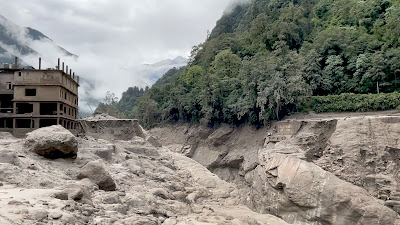One of the major impacts of
the GLOF of 04Oct2023 was its effect on road communications in the
lower parts of the Teesta valley that is, on NH10 which connects Gangtok
to Siliguri.
About NH10
NH10
is an arterial road, vital for the nation’s security; it is the
lifeline for the border state of Sikkim and for Kalimpong district in W
Bengal.
Of the 114km distance
between Siliguri and Gangtok approximately 92 kms of NH10 lies in
mountainous terrain and for much of this distance, the highway winds itself along the banks of the Teesta river. Several
large dams have now been built on the Teesta between Chungthang
(Sikkim) and Coronation bridge (W Bengal) and many more are planned. The
proximity of the river to the highway and the dam activity in this area
has undoubtedly contributed to the instability on NH10. The
44.9km IRCON/NFR single lane railway project between Sevoke and Rangpo
which has 85% of the distance in tunnels also runs close to NH10 along
the valley. This is also creating problems with the excavations from the tunnels and sludge affecting traffic.
This
area receives approx 2500-3000mm of rainfall annually and has a lot of
landslide activity as such there are many 'hotspots' or large and
troublesome landslide areas which routinely disrupt traffic during the monsoons both in the 38km Sikkim section (from Rangpo to Gangtok) and the much longer (62km) W Bengal section (Rangpo to Coronation bridge). The entire region is in earthquake zone IV.
Normally, approx 3500-4000 vehicles ply on NH10 each day from Sikkim, Kalimpong to Siliguri.
The W Bengal section of NH10 is being maintained by the PWD (W Bengal) except for a small portion between Teesta Bazar and Geil Khola which is with NHIDCL. Maintenance of the 28km part in Sikkim from Rangpo to Ranipul is again with NHIDCL
 |
Source: NHIDCL
|
Current problems
The GLOF of 04Oct2023 shredded many parts of NH10 and for some time the Kalimpong - Melli section of the highway and the Kalimpong to 27th mile sections were closed due to damage.
Drone photo of NH10 opposite Melli bazar, on 10Oct2023 which had been eroded away by the GLOF
Part of NH10 towards Sikkim from Teesta bazar after the GLOF on 10Oct2023
Part of particularly troublesome part (between Teesta bazar and Geil khola) of NH10 on 18Oct2023. 'A' is Geil Khola which was severely impacted by the GLOF and 'B' is Likhu Bhir landslide area which has been reactivated by the GLOF.
Vehicular traffic quickly resumed on the Teesta - Gangtok section of NH10 and we could report on the impact of the GLOF at Melli and Bhalukhola on 10Oct2023. The Teesta to Coronation bridge section required more time and was only opened for light vehicles (4 wheelers) and between 6am-6pm on 21Oct2023.
On 04Dec2023 truckers from Kalimpong supported by truck unions from Sikkim and also minibus operators called an indefinite strike alleging long delays in repairing the Teesta - Coronation bridge section of the highway. See map below:
*
ABCF is the normal NH10 route (in the mountains) for all vehicles . Now this route is only OPEN for light vehicles. On this road, the Siliguri - Gangtok distance is 114km and takes approx 4hrs.
* Section
CF is closed for 6 wheeler trucks and buses and other heavy vehicles.
* Because of the CF closure, heavy vehicles from Gangtok and Kalimpong have to detour thru
ABCDEF route ie drive thru Kalimpong town, to Lava & Gorubathan which is 228km and takes approx 7 hrs
OR * Otherwise heavy vehicles have to follow the route shown in blue (241km) ie
ABDEF route which again takes 7 hours plus.
Heavy vehicular movements disrupt traffic as such they are only permitted to ply at night thru urban areas, so I met a truck driver from Sikkim enroute to Siliguri, taking a nap at 10.00am on the roadside, because he had a 7hr drive ahead in the night.
NH717A is under construction and is not available to traffic.
A smaller alternate route from Kalimpong across Relli river then thru Samthar and Panbu and Kalijhora is available for light vehicles. However, this route is not suitable for heavy traffic and is at places desolate.
Lastly, a major problem with the alternate routing thru NH717A and the current Lava - Gorubathan routing is that this area receives almost 4000mm rainfall annually, has severe thundershowers during the monsoons and has a number of large landslide zones such as that in Nimbong.
|
Video of heavy night time traffic thru Pedong bazar courtesy Amod Pradhan
|
Damaged culvert at 11th mile Kalimpong due to movement of heavy trucks from Sikkim and Kalimpong to Siliguri.
Luckily,
the strike was quickly called off with the District Administration
assuring the striking transporters that the Teesta - Coronation section
would be opened to heavy vehicles and buses from 10Dec2023.
In
all this, the plight of truckers and bus operators who have to do a
grueling 7-9hr drive from Gangtok to Siliguri is understandable - it is a
tough and tiring drive, mostly along mountain roads.
Freight
charges of a truck from Siliguri to Kalimpong have gone up from Rs
8,000/- to roughly double that ie Rs 15,000/- and the drivers take two
days to complete a round trip.
On the other hand, the caution on the part of the district administration is also very understandable. The
Teesta bazar to Sevoke section of NH10 has always been a particularly
vulnerable area with numerous 'hotspots' and the GLOF has only made
these places weaker. Opening NH10 to
full traffic in haste and without any restrictions may expose travelers
along the highway to dangerous and weak areas and we have already
witnessed a number of accidents along NH10 recently and even some fatalities.
Praful Rao
Kalimpong district
Darjeeling-Sikkim Himalaya
savethehills@gmail.com
9475033744



















































